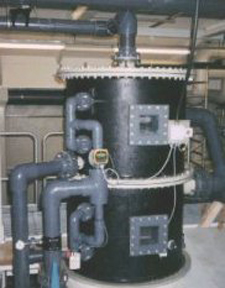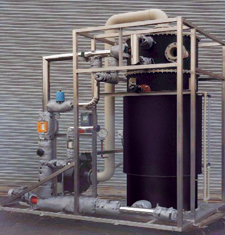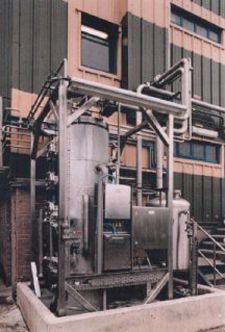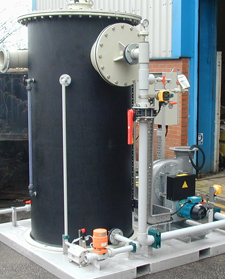





V-tex® Scrubbing
V-tex® technology is an innovative and patented method of scrubbing contamination.
V-tex® scrubbers are designed specifically to suit the particular application and duty. Gas flows treated by V-tex® technology typically vary from 5m3/hr to 20,000m3/hr and from single stage to multiple stage units depending on the contamination removal efficiency requirement.
The materials of construction are selected for the application and ranged from carbon steel to various grades of stainless steel to exotic materials such as Hastelloy and from PVC to various grades of plastics to exotic plastics such as ECTFE or Halar lined high temperature resin GRP vessels.
All systems are specifically designed by experienced chemical engineers to meet their specific duty.
Unique features
These are:
- Scrubbing HCl and other soluble gases to efficiencies > 99% removal in a single stage
- Scrubbing gaseous contamination in multiple stages to achieve greater efficiencies i.e. > 99.99%
- Capturing particulate >2micron to >99% removal in a single stage
- The capability to scrub with viscous liquors such as 20% caustic, mineral oils or 10% suspended solids slurries without risk of fouling
Challenging Environments
The V-tex® scrubbing technology is ideally applicable for challenging applications where:
- The gas contamination is a combination of particulates and acidic gases which if treated by traditional scrubbing would result in fouling
- The gas contamination when it is scrubbed forms a glutinous or fouling by-product
- The scrubbing liquor used is viscous such as percentage level caustic or a mineral oil or solvent
- There is a requirement to minimise the height of the plant
- There is a requirement for minimal maintenance or operator exposure to the scrubbing environment
- There is a requirement to maintain high efficiency scrubbing for a variable gas flow
- There is a requirement for the equipment to be self cleaning
Typical applications
The following are just a few of the duties where V-tex® scrubbing is used:
- Desulphurization, sub cooling and removal of tars from bio-gas from anaerobic digesters and gasifiers.
- Absorption of halogenated gases from pressurized batch processing reactors for the pharmaceutical and fine chemical industries.
- Capture of fine particulate (>2 micron) and halogenated contamination for furnace off-gases for the metal processing industry.
- Capture of silica fine particulate and halogenated gases from optical fibre manufacture and the electronics industry.
- Desulphurization of incinerator flue gases and kiln off-gases using lime slurry or dilute caustic.
- Capture of waste chlorine into concentrated caustic for the manufacture of 15% sodium hypochlorite.
- Capture of naphthalene into mineral oil for subsequent recovery.
- Capture of waste ammonia using dilute sulphuric acid for the manufacture of >12% ammonium sulphate.
- Emergency scrubbing of chlorine for gas storage facilities.
- Desulphurization of boiler flue gases using sea water.
For more applications see the case studies.
Request a Quote If you have questions, telephone +44 (0)1403 221000 or Make an Enquiry